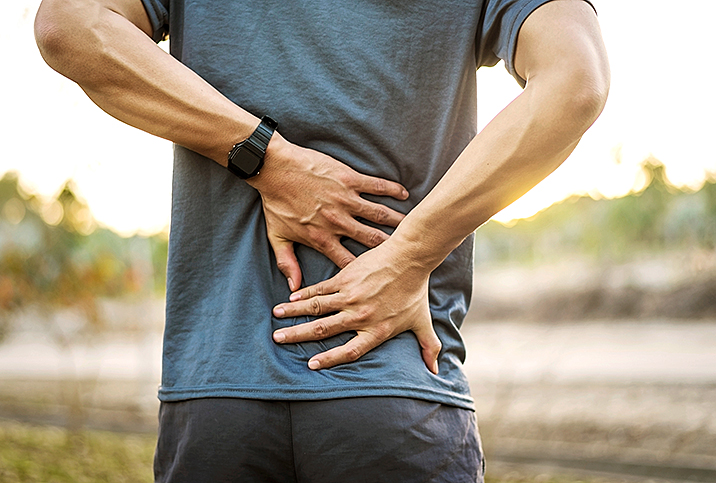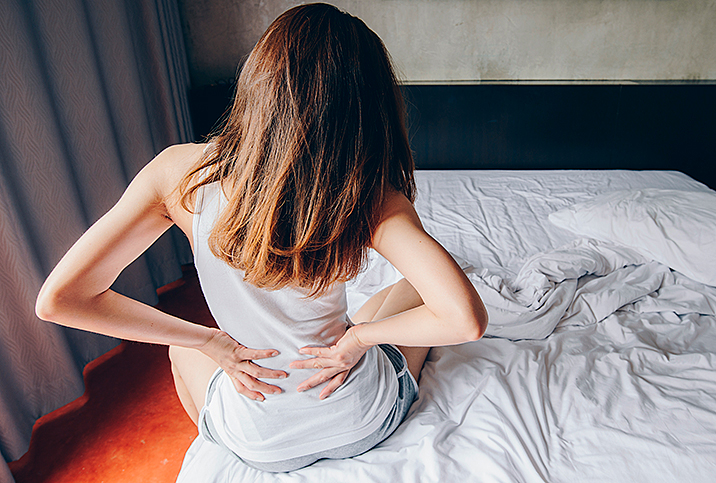Your Back Pain Can Indicate Much More

Aside from thinning hair and wrinkles, one of the biggest signs of aging is how often you groan when standing up. Bonus points if your hand goes to your spine, accompanied by a series of cracking noises.
However, back pain isn't reserved for the elderly. Rather, it's one of the most common issues Americans face, with 65 million reporting recent back pain, according to data from Georgetown's Health Policy Institute. Of those 65 million, 16 million—8 percent of all adults in the United States—reported experiencing chronic back pain, severely limiting their daily activities.
In total, issues relating to back pain cost Americans a whopping $87.6 billion—almost 23 times more than it cost to make the most expensive film of all time, "Pirates of the Caribbean: On Stranger Tides." On a scale that's less about Hollywood and more about you, back pain treatment costs a sufferer about $2,000 every year.
Despite this, we generally don't take back pain seriously, at least not in relation to its severity. Perhaps because 80 percent of us will experience back pain at some point, the American Chiropractic Association reports, we believe it's a non-issue, something a hot shower and a good morning stretch can fix.
However, back pain is the leading cause of disability worldwide. And from 1990 to 2015, the number of disabilities caused by low back pain increased by 54 percent.
What causes back pain?
Back pain can be attributed to a wide range of factors.
"For some people, it's the day-to-day stuff, things like sitting hunched over, spending too long in one position, or constantly stressing the back with repetitive, extreme movements, such as bending," said chiropractor Jacob Barlow. "In more extreme cases, you get someone who's had either serious damage to their spine or nerve damage."
When we talk about the causes of back pain, we also need to look at the risk factors. Barlow said that, in addition to age, the most common risk factors associated with chronic back pain are a sedentary lifestyle, being overweight, stress (physical and emotional) and incidents such as falls or car accidents.
Additionally, studies have linked smoking to an increased risk of intense back pain. Other physical conditions, such as arthritis and scoliosis, are also linked.
Marsha Moore, 67, said her family assumed the worst when she went to the hospital in the summer of 2020—that she was sick with COVID-19. In reality, she'd gone to see a doctor because the pain in her back was so intense, she couldn't get out of bed.
"I've had scoliosis since I was 11 or 12, sometime in adolescence," she said. "But back then, if you wanted to get surgery for it, you had to wear a body cast for a whole year. Doctors at the time told me that the curvature in my spine would settle when I turned 21. Well, they were wrong."
In addition to age, the most common risk factors associated with chronic back pain are a sedentary lifestyle, being overweight, stress (physical and emotional) and incidents such as falls or car accidents.
Most cases of scoliosis are mild, but in some children who have it, the curvature of the spine increases over time, which can decrease the amount of space in the chest and lead to improper function in the lungs. In Moore's case, her spine continued to curve throughout her life, leading to compression in her lungs and everywhere else in her upper body.
"At my age, there wasn't any point in getting surgery," she said. "They can't reverse the curving in my spine. The surgery would just stop it from getting worse, but it's not really worth the money. Now, if I'd been able to get the rods or brace they have now, I'd have probably done it."
Scoliosis affects 2 percent to 3 percent of the general population, but, thankfully, since it's most common in developing children, it can be managed nonsurgically in most cases.
There are also a few forms of arthritis that can affect pain in the back, the most common of which being osteoarthritis, a degenerative form of arthritis caused by wear and tear in the cartilage between joints in the back, most noticeable when twisting or bending. In addition, rheumatoid arthritis and spondyloarthritis each impact the spine in different ways.
Rheumatoid arthritis is an autoimmune disorder more commonly affecting joints elsewhere in the body, though it can show up in the neck and spine, as well.
Spondyloarthritis is the name given to a group of diseases, which each affect different parts of the body, such as the bowels and genitals. Many affect the spine as well, including ankylosing spondylitis (inflammation of the vertebrae), psoriatic arthritis (psoriasis, typically a rash but can affect smaller joints), reactive arthritis (triggered by infection and can sometimes manifest in the lower back) and enteropathic arthritis (linked to inflammatory bowel disease).
Certain conditions can lead to herniated discs in the spine—the rupturing of one of the spine's vertebrae that causes it to leak, potentially leading to nerve damage or damage to the spinal cord.
Management and prevention
"You have to remember, back pain affects your life in just about every way imaginable," Barlow said. "Pain limits your movement. Stiffness limits your movement. People lose enjoyment in activities they're interested in. Extreme cases can inhibit motion and even cause bowel and bladder incontinence."
Given the spine is the central component of the body, it shouldn't be surprising that pain vastly limits our ability to function. The U.S. Department of Health and Human Services outlined a number of practices to help to prevent back pain, including standing and sitting straight, maintaining a healthy weight, exercising frequently, lifting with your legs and doing twice-weekly back stretches and strengthening exercises.
Severe back pain, however, might require a surgical procedure, physical therapy, medication or injections to treat. If you're experiencing chronic back pain—that is, back pain that lasts more than three weeks—it's best to consult a medical professional and find out which treatment plans may work best for you.


















